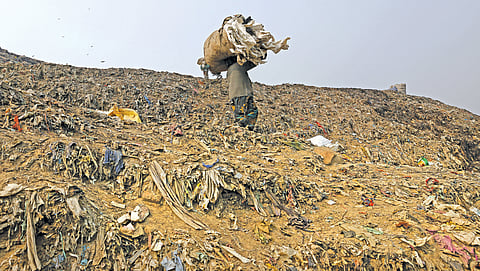A legacy that stinks
While the word “legacy” typically refers to a valuable inheritance from the past, legacy waste is anything but a gift. These vast mounds of accumulated municipal solid waste (MSW) pose severe risks to human health and the environment while also occupying prime urban land. They generate leachate, a foul, dark liquid that kills vegetation around the dumps and irreversibly contaminates water sources, according to India’s Guidelines for Disposal of Legacy Waste, released in February 2019. These sites also emit methane, a greenhouse gas, and frequently catch fire, degrading air quality.
Recognising the challenge, the Union government launched the Swachh Bharat Mission (Urban) 2.0 in 2021, setting an ambitious target to eliminate all legacy waste from cities by 2025-26. However, progress has been sluggish. With a little more than a year remaining, data from the scheme’s dashboard, accessed on February 18, 2025, reveals that India still has 119.1 million tonnes of legacy waste spread across 3,498 hectares. Meanwhile, the country’s failure to scientifically process fresh MSW complicates the matter. In 2021-22, India could only process 46.27 per cent of its MSW, leaving nearly 28.77 million tonnes of fresh waste untreated, according to the Central Pollution Control Board. This ultimately adds to the legacy waste burden.
A fundamental problem is that, despite the target, India does not yet have a formal definition of legacy waste. The legacy waste management guidelines state that the country’s waste management challenge began in the 1970s, when plastics became popular and households started disposing of wet waste in plastic bags. The industry informally considers MSW older than a year as legacy waste.
While legacy waste is easier to process than fresh MSW, it is less profitable (see ‘Easy and yet so difficult’). This is because informal waste pickers have already extracted most of the recyclables, leaving behind largely inert materials with little or no economic value. Due to its composition, the remediation process for legacy waste differs from that of fresh MSW. While fresh MSW is first segregated and then processed for recycling, legacy waste is usually excavated, treated and then sorted.
According to the 2019 guidelines, legacy waste can be managed through either capping or biomining and bioremediation. Capping involves sealing the waste with a protective lining to prevent leachate contamination. This method is less desirable as it does not allow for resource recovery or land reclamation. Biomining is a scientific process that involves excavation, treatment, segregation and repurposing of aged waste. Bioremediation, often used alongside biomining, employs microorganisms to break down semi-digested material, reducing landfill volume and enabling land recovery. One key byproduct of this process is bio-soil, a soil conditioner that can be used as organic manure. Recovered inert materials can be repurposed for road construction or land development, while recyclable materials, including construction waste, can be processed for reuse. Additionally, refuse-derived fuel (RDF), made from the combustible components of MSW, can be used in cement and waste-to-energy plants as an alternative to fossil fuels.
Malpractices galore
Biomining projects in India rely solely on tipping fees paid by the Centre and state governments.
India’s first bioremediation project was carried out in Tamil Nadu in 2016, with a tipping fee of Rs 1,200 per tonne. Today, the fee has dropped to Rs 500-550, largely due to limited revenue streams and intense competition, forcing private operators to bid at extremely low margins. The payment turnaround period—the time between raising an invoice and receiving the tipping fee—for biomining projects varies from 90 to 180 days, further increasing the financial burden on private players.
This has resulted in substandard remediation, with some contractors bypassing the legacy waste management guidelines. This reduces the quality of bio-soil and RDF, making such projects even less viable. There have been instances in the past when cement and waste-to-energy plants have demanded payment from legacy waste recyclers due to the poor quality of RDF.
Ensuring the success of biomining in India will require stricter quality control and oversight. Authorities must adopt a selection system that prioritises both quality and cost-effectiveness when awarding contracts. A thorough assessment of vendors’ technical and commercial credentials should be mandatory. Regular monitoring—both on-site and digital—can help track compliance and prevent malpractices. Furthermore, these projects require a substantial payment towards the “Earnest Money Deposit” and/or “Performance Bank Guarantee”, typically ranging from 2 per cent to 10 per cent of the total project cost. To promote the participation of micro, small and medium enterprises (MSMEs), these financial requirements could either be eliminated or significantly reduced.
Encouraging participation from non-profits, startups and micro-scale enterprises can also help accelerate the remediation process. Finally, enforcing strict penalties for statutory non-compliance will be essential in ensuring that India meets its 2025-26 target for eliminating legacy waste.
(Atun Roy Choudhury is the assistant general manager with waste management company Cube Bio Energy. Jitesh Lalwani is assistant professor at Woxsen University, Hyderabad. Sovik Das is assistant professor at the Indian Institute of Technology, Delhi. Neha Singh is a manager with Unison i3x, a waste management company)
This was first published in the 1-15 March, 2025 print edition of Down To Earth

